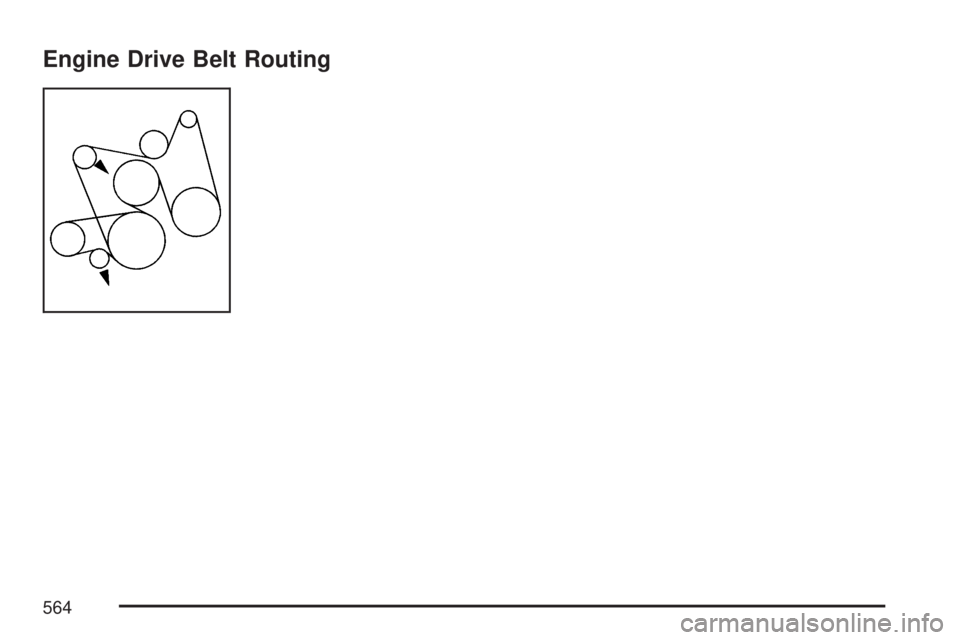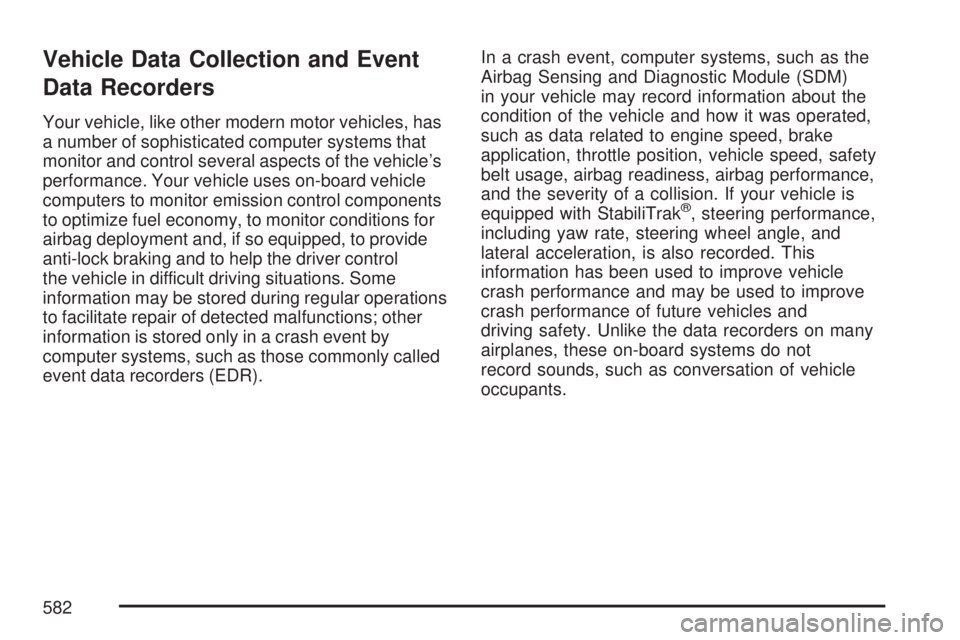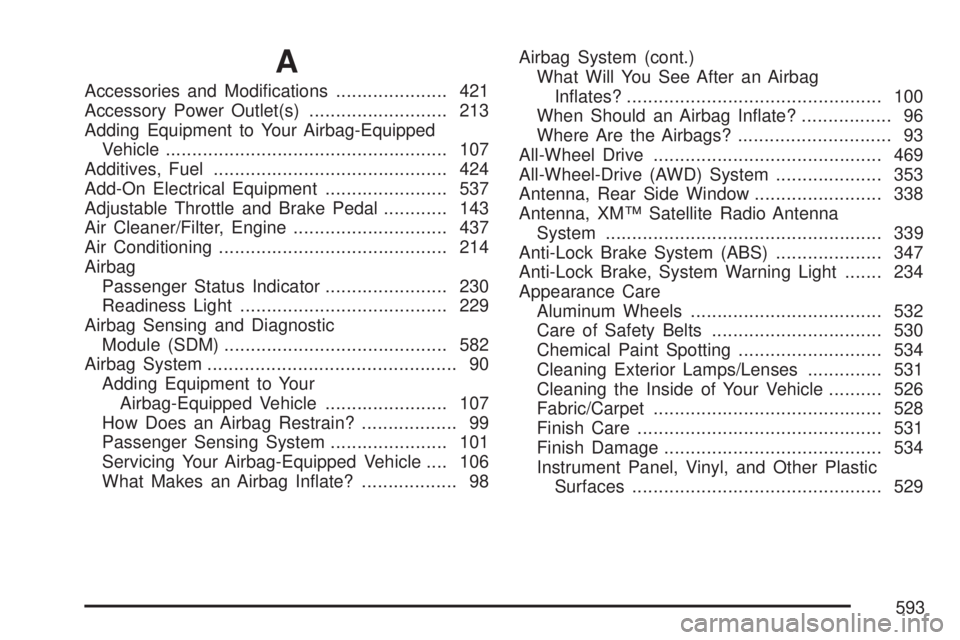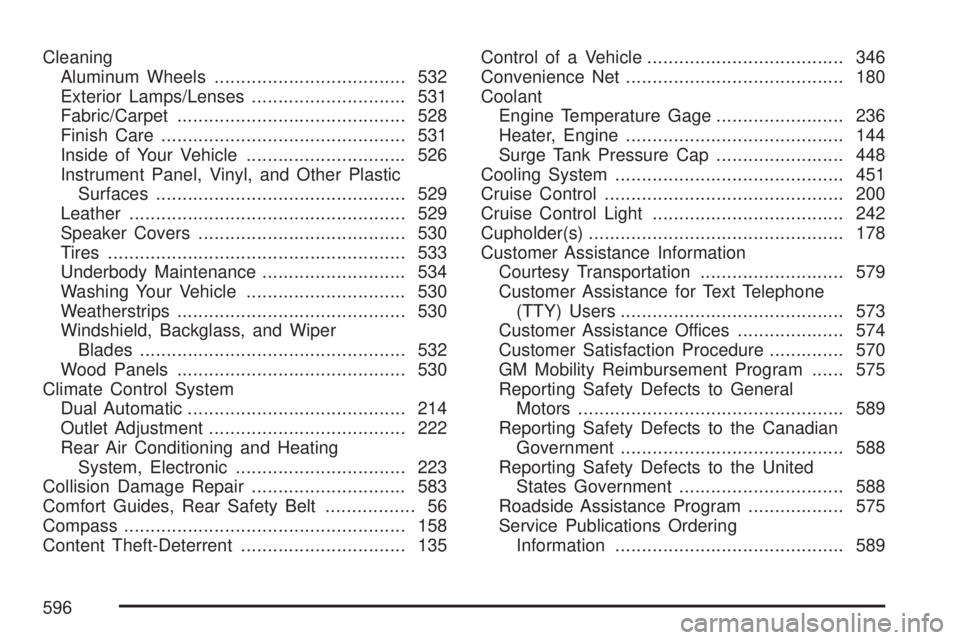2007 GMC YUKON XL DENALI belt
[x] Cancel search: beltPage 555 of 608

Additional Required Services (cont’d)
Service and Miles (Kilometers)25,000
(40 000)50,000
(80 000)75,000
(120 000)100,000
(160 000)125,000
(200 000)150,000
(240 000)
Replace spark plugs and inspect spark
plug wires.An Emission Control
Service.•
Engine cooling system service (or every
�ve years, whichever occurs �rst).
An Emission Control Service.
See footnote (i).•
Inspect engine accessory drive belt.
An Emission Control Service.
See footnote (l).•
Maintenance Footnotes
†The U.S. Environmental Protection Agency or
the California Air Resources Board has determined
that the failure to perform this maintenance item
will not nullify the emission warranty or limit
recall liability prior to the completion of the
vehicle’s useful life. We, however, urge that all
recommended maintenance services be performed
at the indicated intervals and the maintenance
be recorded.#Lubricate the front suspension, steering linkage,
transmission shift linkage, and parking brake
cable guides. Control arm ball joints are
maintenance-free.
(a)Visually inspect brake lines and hoses for
proper hook-up, binding, leaks, cracks, cha�ng,
etc. Inspect disc brake pads for wear and rotors
for surface condition. Inspect other brake
parts, including calipers, parking brake, etc.
555
Page 556 of 608

(b)Visually inspect front and rear suspension and
steering system for damaged, loose, or missing
parts, signs of wear, or lack of lubrication. Inspect
power steering lines and hoses for proper
hook-up, binding, leaks, cracks, cha�ng, etc.
Visually check constant velocity joints, rubber
boots, and axle seals for leaks.
(c)Visually inspect hoses and have them replaced
if they are cracked, swollen, or deteriorated.
Inspect all pipes, �ttings, and clamps; replace with
genuine GM parts as needed. To help ensure
proper operation, a pressure test of the cooling
system and pressure cap and cleaning the outside
of the radiator and air conditioning condenser is
recommended at least once a year.
(d)Visually inspect wiper blades for wear or
cracking. Replace wiper blades that appear worn
or damaged or that streak or miss areas of
the windshield.(e)Make sure the safety belt reminder light and all
your belts, buckles, latch plates, retractors, and
anchorages are working properly. Look for
any other loose or damaged safety belt system
parts. If you see anything that might keep a safety
belt system from doing its job, have it repaired.
Have any torn or frayed safety belts replaced. Also
look for any opened or broken airbag coverings,
and have them repaired or replaced. The
airbag system does not need regular maintenance.
(f)Lubricate all key lock cylinders, hood latch
assembly, secondary latch, pivots, spring anchor,
release pawl, door hinges, liftgate hinge, liftgate
linkage, liftgate handle pivot points, latch bolt, fuel
door hinge, locks, and folding seat hardware.
More frequent lubrication may be required when
exposed to a corrosive environment. Applying
silicone grease on weatherstrips with a clean cloth
will make them last longer, seal better, and not
stick or squeak.
556
Page 557 of 608

(g)Inspect system. Check all fuel and vapor
lines and hoses for proper hook-up, routing, and
condition. Check that the purge valve works
properly, if equipped. Replace as needed.
(h)Change automatic transmission �uid and �lter
if the vehicle is mainly driven under one or
more of these conditions:
�In heavy city traffic where the outside
temperature regularly reaches 90°F (32°C)
or higher.
�In hilly or mountainous terrain.
�When doing frequent trailer towing.
�Uses such as found in taxi, police, or delivery
service.
(i)Drain, �ush, and re�ll cooling system. This
service can be complex; you should have
your dealer perform this service. See Engine
Coolant on page 445 for what to use. Inspect
hoses. Clean radiator, condenser, pressure
cap, and �ller neck. Pressure test the cooling
system and pressure cap.(j)A �uid loss in any vehicle system could indicate
a problem. Have the system inspected and
repaired and the �uid level checked. Add �uid if
needed.
(k)If you drive regularly under dusty conditions,
inspect the �lter at each engine oil change.
(l)Visually inspect belt for fraying, excessive
cracks, or obvious damage. Replace belt if
necessary.
(m)Check vent hose at transfer case for kinks
and proper installation.
Owner Checks and Services
These owner checks and services should be
performed at the intervals speci�ed to help
ensure the safety, dependability, and emission
control performance of your vehicle. Your
GM Goodwrench
®dealer can assist you with
these checks and services.
Be sure any necessary repairs are completed at
once. Whenever any �uids or lubricants are added
to your vehicle, make sure they are the proper
ones, as shown inRecommended Fluids and
Lubricants on page 561.
557
Page 564 of 608

Engine Drive Belt Routing
564
Page 582 of 608

Vehicle Data Collection and Event
Data Recorders
Your vehicle, like other modern motor vehicles, has
a number of sophisticated computer systems that
monitor and control several aspects of the vehicle’s
performance. Your vehicle uses on-board vehicle
computers to monitor emission control components
to optimize fuel economy, to monitor conditions for
airbag deployment and, if so equipped, to provide
anti-lock braking and to help the driver control
the vehicle in difficult driving situations. Some
information may be stored during regular operations
to facilitate repair of detected malfunctions; other
information is stored only in a crash event by
computer systems, such as those commonly called
event data recorders (EDR).In a crash event, computer systems, such as the
Airbag Sensing and Diagnostic Module (SDM)
in your vehicle may record information about the
condition of the vehicle and how it was operated,
such as data related to engine speed, brake
application, throttle position, vehicle speed, safety
belt usage, airbag readiness, airbag performance,
and the severity of a collision. If your vehicle is
equipped with StabiliTrak
®, steering performance,
including yaw rate, steering wheel angle, and
lateral acceleration, is also recorded. This
information has been used to improve vehicle
crash performance and may be used to improve
crash performance of future vehicles and
driving safety. Unlike the data recorders on many
airplanes, these on-board systems do not
record sounds, such as conversation of vehicle
occupants.
582
Page 593 of 608

A
Accessories and Modi�cations..................... 421
Accessory Power Outlet(s).......................... 213
Adding Equipment to Your Airbag-Equipped
Vehicle..................................................... 107
Additives, Fuel............................................ 424
Add-On Electrical Equipment....................... 537
Adjustable Throttle and Brake Pedal............ 143
Air Cleaner/Filter, Engine............................. 437
Air Conditioning........................................... 214
Airbag
Passenger Status Indicator....................... 230
Readiness Light....................................... 229
Airbag Sensing and Diagnostic
Module (SDM).......................................... 582
Airbag System............................................... 90
Adding Equipment to Your
Airbag-Equipped Vehicle....................... 107
How Does an Airbag Restrain?.................. 99
Passenger Sensing System...................... 101
Servicing Your Airbag-Equipped Vehicle.... 106
What Makes an Airbag In�ate?.................. 98Airbag System (cont.)
What Will You See After an Airbag
In�ates?................................................ 100
When Should an Airbag In�ate?................. 96
Where Are the Airbags?............................. 93
All-Wheel Drive........................................... 469
All-Wheel-Drive (AWD) System.................... 353
Antenna, Rear Side Window........................ 338
Antenna, XM™ Satellite Radio Antenna
System.................................................... 339
Anti-Lock Brake System (ABS).................... 347
Anti-Lock Brake, System Warning Light....... 234
Appearance Care
Aluminum Wheels.................................... 532
Care of Safety Belts................................ 530
Chemical Paint Spotting........................... 534
Cleaning Exterior Lamps/Lenses.............. 531
Cleaning the Inside of Your Vehicle.......... 526
Fabric/Carpet........................................... 528
Finish Care.............................................. 531
Finish Damage......................................... 534
Instrument Panel, Vinyl, and Other Plastic
Surfaces............................................... 529
593
Page 595 of 608

Bucket Seats, Rear....................................... 25
Bulb Replacement....................................... 476
Halogen Bulbs......................................... 476
Headlamp Aiming..................................... 473
License Plate Lamps................................ 477
Replacement Bulbs.................................. 478
Taillamps, Turn Signal, Stoplamps and
Back-up Lamps..................................... 476
Buying New Tires........................................ 498
C
Calibration................................................... 158
California Fuel............................................. 424
California Proposition 65 Warning................ 421
Canadian Owners........................................... 3
Capacities and Speci�cations...................... 546
Carbon Monoxide.....126, 128, 156, 386, 400
Care of
Safety Belts............................................. 530
Your CD and DVD Player........................ 338
Your CDs and DVDs................................ 338
Cargo Cover............................................... 181Cargo Management System........................ 182
Center Console Storage Area...................... 179
Center Front Passenger Position, Safety
Belts.......................................................... 52
Chains, Tire................................................. 504
Charging System Light................................ 232
Check
Engine Light............................................ 237
Checking Things Under the Hood................ 428
Chemical Paint Spotting.............................. 534
Child Restraints
Child Restraint Systems............................. 68
Infants and Young Children........................ 64
Lower Anchors and Tethers for Children..... 74
Older Children........................................... 61
Securing a Child Restraint in a Rear Seat
Position.................................................. 83
Securing a Child Restraint in the Center
Front Seat Position................................. 85
Securing a Child Restraint in the Right
Front Seat Position................................. 86
Where to Put the Restraint........................ 72
Cigarette Lighter.......................................... 214
595
Page 596 of 608

Cleaning
Aluminum Wheels.................................... 532
Exterior Lamps/Lenses............................. 531
Fabric/Carpet........................................... 528
Finish Care.............................................. 531
Inside of Your Vehicle.............................. 526
Instrument Panel, Vinyl, and Other Plastic
Surfaces............................................... 529
Leather.................................................... 529
Speaker Covers....................................... 530
Tires........................................................ 533
Underbody Maintenance........................... 534
Washing Your Vehicle.............................. 530
Weatherstrips........................................... 530
Windshield, Backglass, and Wiper
Blades.................................................. 532
Wood Panels........................................... 530
Climate Control System
Dual Automatic......................................... 214
Outlet Adjustment..................................... 222
Rear Air Conditioning and Heating
System, Electronic................................ 223
Collision Damage Repair............................. 583
Comfort Guides, Rear Safety Belt................. 56
Compass..................................................... 158
Content Theft-Deterrent............................... 135Control of a Vehicle..................................... 346
Convenience Net......................................... 180
Coolant
Engine Temperature Gage........................ 236
Heater, Engine......................................... 144
Surge Tank Pressure Cap........................ 448
Cooling System........................................... 451
Cruise Control............................................. 200
Cruise Control Light.................................... 242
Cupholder(s)................................................ 178
Customer Assistance Information
Courtesy Transportation........................... 579
Customer Assistance for Text Telephone
(TTY) Users.......................................... 573
Customer Assistance Offices.................... 574
Customer Satisfaction Procedure.............. 570
GM Mobility Reimbursement Program...... 575
Reporting Safety Defects to General
Motors.................................................. 589
Reporting Safety Defects to the Canadian
Government.......................................... 588
Reporting Safety Defects to the United
States Government............................... 588
Roadside Assistance Program.................. 575
Service Publications Ordering
Information........................................... 589
596